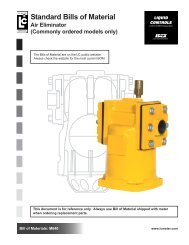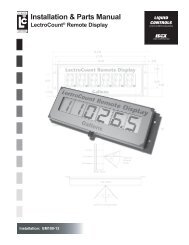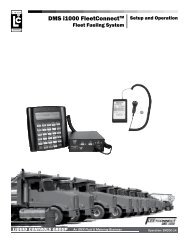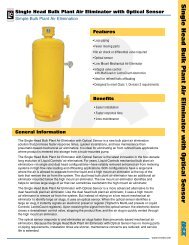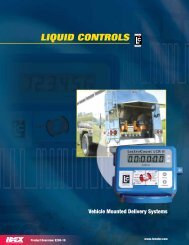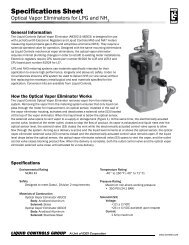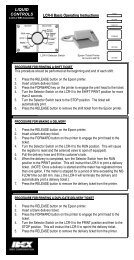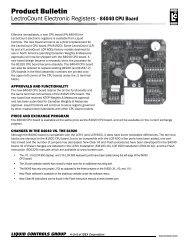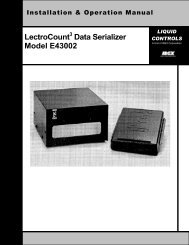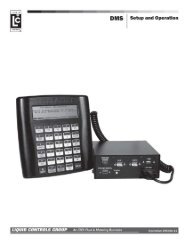LCMag Product Overview - Liquid Controls
LCMag Product Overview - Liquid Controls
LCMag Product Overview - Liquid Controls
You also want an ePaper? Increase the reach of your titles
YUMPU automatically turns print PDFs into web optimized ePapers that Google loves.
General Information<br />
<strong>LCMag</strong> meters are available in a full selection of configurations and sizes. Models are available in flow ranges from 0.10<br />
GPM to 400,000 GPM and in process fittings from 1/8" NPT to 72" for the flanged meters and up to 80" for the insertion<br />
meters. Connections include flanged, threaded, wafer, pipe clamp, and sanitary. Scaled, digital pulse output is standard.<br />
Analog outputs of 0–20mA or 4–20mA are available. RS-232 or RS-485 serial interfaces are available on various models.<br />
Profibus DP is available as an option for HML210 only.<br />
Function & Construction of the <strong>LCMag</strong> Flow Sensor<br />
<strong>LCMag</strong> Meters consist of a sensor and an integrally mounted or<br />
remote mounted converter. The <strong>LCMag</strong> Flow Sensor consists<br />
of a lined flow tube, two electromagnetic coils (M), and two<br />
diametrically opposed electrodes (E1 & E2). Faraday’s Law<br />
of Electromagnetic Induction is the basis for magnetic flow<br />
measurement.<br />
Faraday’s Law postulates that when a magnetic field is created at<br />
right angles to the flow tube through which a conductive liquid is<br />
flowing, the voltage induced in the electrodes (immersed in the<br />
fluid) is proportional to the velocity of the liquid. This induced<br />
voltage is converted to a scaled digital pulse output and to a<br />
4–20mA (or 0–20mA) analog output by the converter. The analog<br />
output signal is a linear output directly proportional to rate of<br />
flow.<br />
The flow sensor consists of a stainless steel pipe section with an internal, insulating liner. PTFE, Polypropylene,<br />
Polyurethane, and Ebonite (hard rubber) liners are available. The two electrodes are positioned opposite each other on the<br />
internal surface of the pipe. The coils, which generate the magnetic field, are placed outside the pipe. The complete sensor<br />
has an IP67/68 protection rating. The choice of materials in contact with the fluid (lining, electrodes, etc.) depends on the<br />
temperature, the chemical aggressiveness of the liquid, and the degree of abrasiveness of the liquid.



